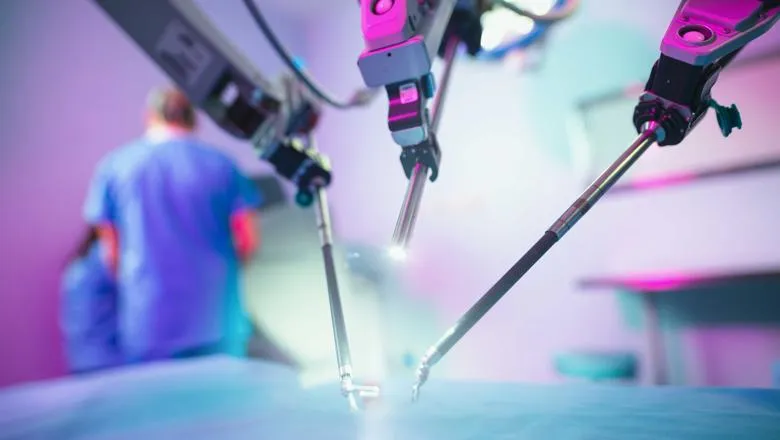Our retina is extremely thin, with a width no more than that of the human hair. The precision required from surgeons is having to almost dissect the human hair. For surgeons to deliver the life-changing stem cells manually obviously includes an element of risk. With our unique system surgeons have the technical capabilities to perform these surgeries more safely and more successfully.
Lead researcher Dr Christos Bergeles, School of Biomedical Engineering & Imaging Sciences
01 March 2022
NIHR i4i award received for first-time retinal surgery robot
The researchers say they their system augments delicate retinal surgery by offering micrometer-range precision and information about interactions between tools and tissues

Researchers from the School of Biomedical Engineering & Imaging Sciences, in collaboration with University of Kent and Moorfields Eye Hospital, have received a £1.5M award from the National Institute for Health Research (NIHR), the research partner of the NHS, public health and social care, for their robotic system designed to deliver regenerative therapies to the human retina.
To deliver regenerative therapies such as stem cells to delicate retinal layers, some of which are as thin as 10-20 micrometers, surgeons currently use a hand-held needle which requires precision and visualisation beyond human capabilities.
The proposed snake-like robotic system will be equipped with force sensing and imaging capabilities to boost the performance of surgeons and fulfil the most challenging precision requirements.
These types of surgeries are for treating Age-Related Macular Degeneration (AMD) which is a primary cause of sight loss in the UK and worldwide, accounting for over 34 percent of the healthcare costs attributed to sight loss.
The economic burden on NHS and the UK from AMD alone is more than £1billion. With vision restoration, costs relating to therapy, nursing and caring will be diminished by more than £350 million per annum.
The developed robot will work with any type of approved therapy, ensuring that they are delivered locally exactly as it was intended.
An exciting collaboration engaging UK expertise straddling physics, biomedical engineering, robotics, ophthalmology and surgery will be supported by the NIHR. Led by King’s College London, this consortium aims to address one of the major limitations of regenerative therapy in delivery of drugs and cells to exact locations in the retina.
Co-Investigator, Professor Adrian Podoleanu, University of Kent
The researchers say they their system augments surgery by offering micrometer-range precision and information about interactions between tools and tissues. This way, the surgeon can know exactly the level of force that is being applied, and therefore not risk any damage to the sensitive tissue. This is currently impossible with manual surgery, as the applied forces are below what humans can feel.
Also to be developed will be the sensors to see through the retina directly from the robot’s tip with optical coherence tomography, a non-invasive imaging technology used to obtain high resolution cross-sectional images of the retina.
A semi-automated stabilisation system will aid when steady prolonged therapy delivery is required.
“Similar to a lane-following vehicle, the developed algorithms will allow the robot to maintain its targeting at predetermined locations in the retina and account for physiological patient motion. The plurality of sensors will allow for targeted safe delivery of regenerative therapies anywhere in the retina,” Dr Bergeles said.
Success has already been demonstrated for certain types of stem cell therapies, including based on a seminal clinical study by our team at Moorfields. There is now evidence that degenerative eye diseases may be reversable with new therapies. However, these must be precisely delivered. With our proposed robotic system the success of novel therapies will not be held back by limitations in conventional retinal surgery techniques.
Prof Lyndon da Cruz from Moorfields Eye Hospital, Project clinical co-lead
This project is funded by the National Institute for Health Research (NIHR) i4i Call 21 A Stage 2. The views expressed are those of the authors and not necessarily those of the NIHR or the Department of Health and Social Care.

